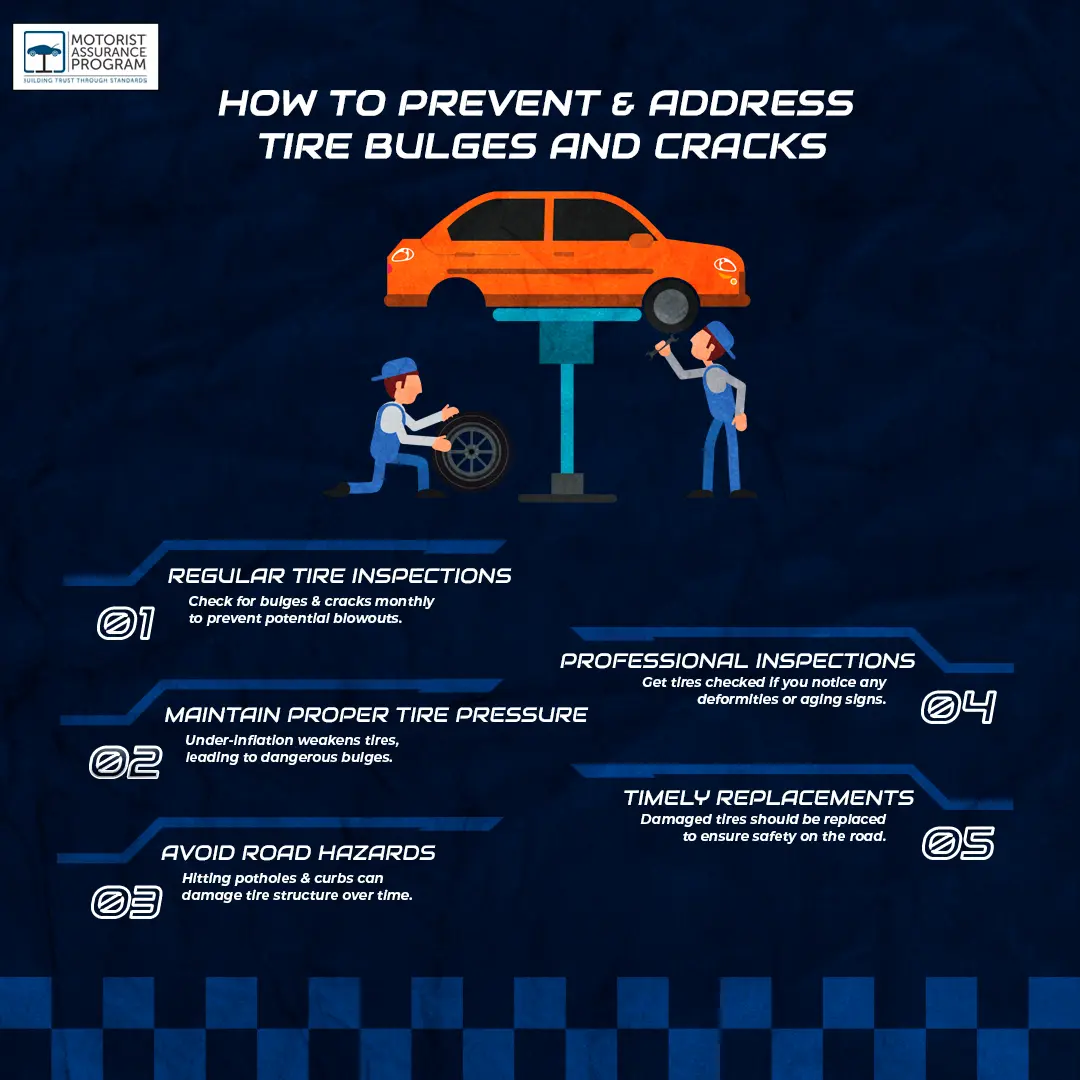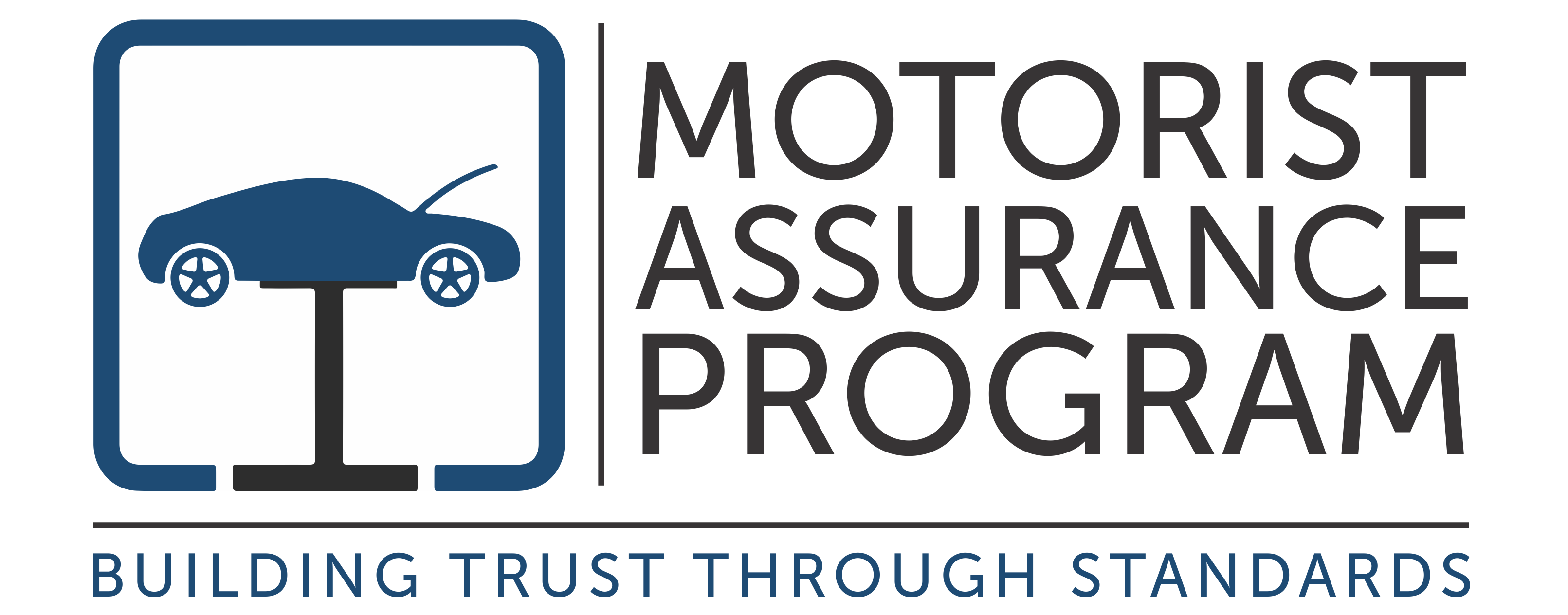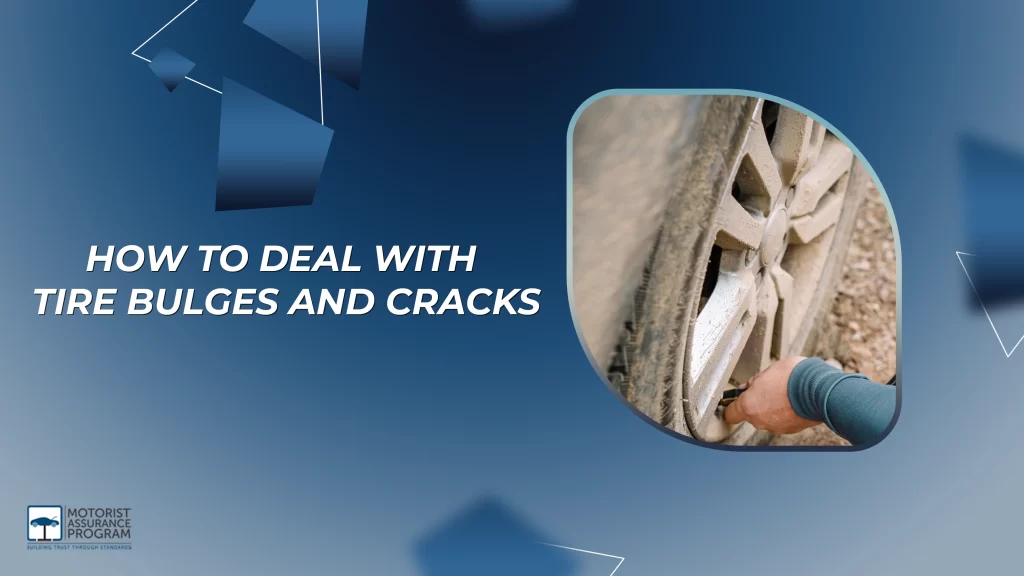If you notice bulges or cracks on your tires, it’s essential to act fast. Don’t drive on damaged tires, as this can lead to blowouts or serious accidents. Get a professional inspection to assess the damage; some issues might require a replacement. Regular maintenance, like checking tire pressure and inspecting for irregularities, can help prevent these problems in the future. You’ll want to learn more about how to keep your tires in top shape.

Key Takeaways
- Inspect your tires regularly for any signs of bulges or cracks to catch issues early.
- Maintain proper tire pressure to prevent uneven wear that can lead to bulges and cracks.
- Seek professional inspection immediately if you notice any tire bulges or cracks.
- Understand that severe bulges may require a tire replacement instead of repair.
- Schedule regular tire maintenance to prolong tire life and ensure safety on the road.
Identify the Warning Signs Early
While you might not think about your tires often, keeping an eye out for warning signs can save you from bigger problems down the road. One major sign to look for is tire bulging at the bottom, which could indicate a serious issue. A tire bulge cause often stems from impacts or under-inflation that weaken the tire’s structure. Additionally, if you notice any cracks in your tires, it’s vital to understand what causes cracks in tires—they can lead to blowouts or loss of control while driving. Regularly inspecting your tires for these warning signs helps guarantee your safety and prolongs the life of your tires. Don’t wait until it’s too late; make tire maintenance a priority.
Understand the Causes of Tire Bulges and Cracks
Identifying tire bulges and cracks is just the first step; understanding their causes is equally important. Tire bulges often result from impacts, like hitting a pothole or curb, which can damage the internal structure of the tire. Over time, this can lead to weakened areas that form bulges. On the other hand, tire cracks are usually caused by exposure to environmental factors such as UV rays, moisture, and extreme temperatures. These elements can dry out the rubber, making it more susceptible to damage. Additionally, improper tire pressure can exacerbate both tire bulges and cracks, leading to uneven wear. By knowing what causes bulges in tires and tire cracks, you can take proactive steps to maintain your tires effectively.
Avoid Driving on Damaged Tires
If you notice tire bulges or cracks, it’s vital to avoid driving on those damaged tires. A tire with a bulge can compromise your safety, as it’s more prone to blowouts. You might wonder, “Why does my car tire have a bulge?” This can be due to hitting a pothole or damage from under-inflation. Similarly, if you see cracks on the sidewall of your tire, they indicate age or structural weakness. Ignoring these signs can lead to serious accidents or costly repairs down the line. Remember, your tires are the only contact between your vehicle and the road, so prioritizing their condition is important. Stay safe and don’t risk driving on damaged tires.
Seek Professional Inspection and Replacement
When you notice tire bulges or cracks, seeking professional inspection and replacement should be your next step. You might wonder, “Why is my tire bulging out?” Bulges often indicate internal damage, leading to tire failure if not addressed. A trained technician can assess the extent of the damage and determine if tire bulge repair is possible. However, it’s essential to understand that not all bulges can be fixed. If the damage is severe, a replacement will be necessary to guarantee your safety on the road. Don’t gamble with your safety; addressing these issues promptly can prevent further complications. Reach out to a qualified service provider to discuss your options and keep your vehicle in top shape.
Prevent Future Issues with Regular Maintenance
To prevent future issues with tire bulges and cracks, regular maintenance is essential for your vehicle’s health. Keeping an eye on your tires can help you catch any problems early on. Inspect your tires regularly for signs of a tire bulge in the tread or cracks in between tire treads. If you notice any abnormalities, address them immediately to avoid further damage. It’s also important to check the sidewalls for cracks, which often lead to more serious issues. Make certain your tires are properly inflated and rotated according to the manufacturer’s recommendations. This can help you understand why your tires are cracking on the side and guarantee a smoother, safer ride. Regular maintenance keeps your tires in top shape, prolonging their lifespan.
Frequently Asked Questions
Can I Repair a Tire With a Bulge or Crack?
You can’t repair a tire with a bulge or crack. These issues compromise safety and integrity. It’s best to replace the tire to guarantee your vehicle operates safely and efficiently on the road. Stay safe!
How Long Can I Drive on a Damaged Tire?
Driving on a damaged tire’s like walking on thin ice; it’s risky. You shouldn’t drive long distances on it—ideally, get it checked immediately. Safety is paramount, and a damaged tire can lead to serious accidents.
What Are the Risks of Ignoring Tire Damage?
Ignoring tire damage can lead to severe risks, including blowouts, loss of vehicle control, and reduced traction. You’re putting your safety and others at risk, so it’s essential to address any visible issues promptly.
Do Tire Warranties Cover Bulges and Cracks?
Tire warranties often don’t cover bulges and cracks, as these issues typically result from impact damage or improper inflation. It’s essential to read your warranty’s terms carefully to understand what’s included and excluded.
How Often Should I Inspect My Tires for Damage?
You should inspect your tires for damage at least once a month. Look for any signs of wear or abnormalities, especially before long trips. Regular checks can help guarantee your safety on the road.
Conclusion
To sum up, keeping an eye on your tires is like nurturing a garden; neglect can lead to weeds that ruin the whole landscape. Just like a small crack in the ground can swiftly turn into a big problem for your plants, a tiny bulge or crack can jeopardize your safety on the road. Regular checks and prompt action can help you maintain a healthy, safe driving experience. Don’t wait—tend to those tires before they sprout bigger issues!


